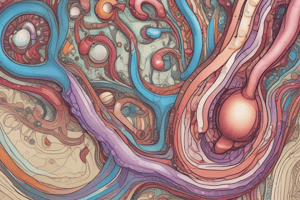Podcast
Questions and Answers
Values below 1.0 indicate that the substance is reabsorbed more avidly than ______.
Values below 1.0 indicate that the substance is reabsorbed more avidly than ______.
water
The ______ of Henle is divided into thin descending and thick ascending segments.
The ______ of Henle is divided into thin descending and thick ascending segments.
loop
The distal tubule is a ______ segment.
The distal tubule is a ______ segment.
diluting
Thiazide diuretics act on the ______ tubule.
Thiazide diuretics act on the ______ tubule.
Principal cells in the late distal tubule and cortical collecting tubule ______ sodium and secrete potassium.
Principal cells in the late distal tubule and cortical collecting tubule ______ sodium and secrete potassium.
Potassium-sparing diuretics act on ______ cells.
Potassium-sparing diuretics act on ______ cells.
Intercalated cells ______ hydrogen ions and reabsorb bicarbonate and potassium ions.
Intercalated cells ______ hydrogen ions and reabsorb bicarbonate and potassium ions.
The medullary collecting duct reabsorbs only ______% of the filtered water and sodium.
The medullary collecting duct reabsorbs only ______% of the filtered water and sodium.
The permeability of the medullary collecting duct to water is ______ dependent.
The permeability of the medullary collecting duct to water is ______ dependent.
The medullary collecting duct is capable of ______ H ions and plays a key role in acid-base regulation.
The medullary collecting duct is capable of ______ H ions and plays a key role in acid-base regulation.
Flashcards are hidden until you start studying
Study Notes
Reabsorption Mechanisms
- Reabsorption of chloride, urea, and other solutes occurs through passive diffusion, coupled with sodium reabsorption
- 65% of filtered sodium, chloride, bicarbonate, and potassium, and essentially all filtered glucose and amino acids are reabsorbed by the proximal tubule
Proximal Tubule
- Reabsorbs 65% of filtered sodium, chloride, bicarbonate, and potassium, and essentially all filtered glucose and amino acids
- Concentrations of solutes along the proximal tubule can be seen in fig 7
- Secretes organic acids and bases
Loop of Henle
- Composed of three functionally distinct segments: thin descending segment, thin ascending segment, and thick ascending segment
- Thick ascending segment reabsorbs sodium, chloride, and potassium (fig 8-B)
Active Transport
- Primary active transport linked to hydrolysis of ATP (fig 2)
- Secondary active reabsorption through the tubular membrane (fig 3)
- Secondary active secretion into the tubules (fig 3)
- Pinocytosis: an active transport mechanism for reabsorption of proteins
- Transport maximum for substances that are actively reabsorbed (fig 4)
Distal Tubule and Collecting Duct
- Forms part of the juxtaglomerular apparatus (JGA)
- Diluting segment
- Site of action of thiazide diuretics
- Principal cells reabsorb sodium and secrete potassium (fig 10)
- Intercalated cells avidly secrete hydrogen and reabsorb bicarbonate and potassium ions
- Medullary collecting duct reabsorbs only 10% of filtered water and sodium, permeability to water is ADH dependent
Studying That Suits You
Use AI to generate personalized quizzes and flashcards to suit your learning preferences.




